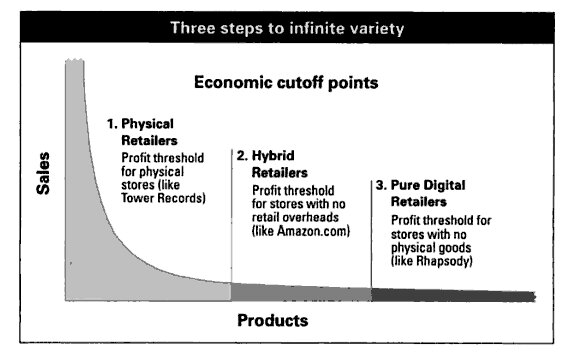The Long Tail: Why the Future of Business is Selling Less of More by Chris Anderson
In comparison to David Meerman Scott's Real-Time Marketing & PR, Anderson's The Long Tail offers a rather sophisticated economic analysis of how the Internet is changing business. Anderson focuses mostly on the media and entertainment industries (probably because of his background as editor-in-chief of Wired), but he does do a superb job of extending his analysis to traditional retail (by examining Amazon.com and eBay). Anderson's research is a bit outdated—most of his data comes from before 2006, when the first edition of his book was published—but his theories are still relevant five years later. In 2008 he published an expanded second edition with an additional chapter on "The Long Tail of Marketing."
Anderson argues that the Internet is lowering the traditional costs of retail. In the past, companies were forced to offer only "hits" that had mass appeal. The world of physical products is inherently limited and there are opportunity costs to carrying on product over another. A movie has to earn enough at the box office to justify giving it screen time; a television program has to attract enough of an audience justify its spot in prime-time; and a CD has to earn shelf space by selling more copies than a less-popular album.
But, online, companies can offer infinite variety with little-to-no distribution costs. Services like Rhapsody.com or Netflix can offer thousands of mp3s or movie titles and deliver them to the consumer for the price of a broadband connection. Listing another product only costs (ever-cheaper) space on a server. Media companies can tap "the long tail" of the demand curve:
(The Long Tail 92)
The curve extends asymptotically: as Rhapsody added more mp3s to its library, it found that every single one of them sold.
Anderson's insight is that, in aggregate, these niche products can comprise a significant market. By examining companies from KitchenAid to LEGO—which have both physical and digital store fronts—he finds that online sales are becoming an increasingly large portion of revenue and profits.
(The Long Tail 132)
Because enthusiasts are often willing to pay more for niche products, the margins on them can be higher.
There are several implications of this long-tail shift. The first is that, as any microeconomist will tell you (and Anderson worked with Hal Varian, author of my microeconomics textbook), greater choice unambiguously increases welfare: consumers can find precisely the product they want at the price they are willing to pay. Secondly, consumers have more power than ever before because they can voice their opinions via blogs or product reviews ("twist[ing] some arms" with marketing “can only do so much" (232-233)). Ultimately, Anderson foresees mass culture fragmenting into tightly-knit, globe-spanning niches.
The challenge is to help consumers navigate this sea of variety. Long-tail businesses can crowdsource production and increase variety by aggregating the inventories of thousands of sellers (think Amazon Marketplace or eBay), but Anderson suggests that they can also play a (third) role as filters. With smart recommendation software (think Pandora's music genome project), retailers can lead consumers to new products they are likely to buy.
Finally, Anderson does an excellent job of placing the long-tail shift in historical context by examining the distribution innovations by Sears, Roebuck, and Co. and the cultural transformation caused by the home VCR.


